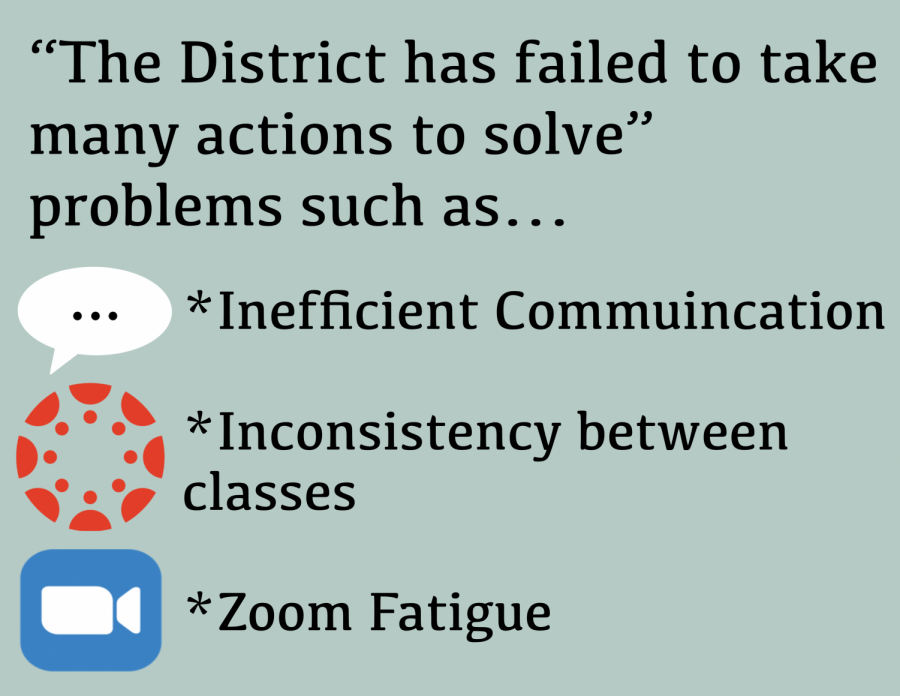The trials and tribulations of distance learning
Many students are having issues with learning platforms, zoom fatigue and more. The District has failed to take many actions to solve these problems, primarily through failing to open avenues for student feedback and not communicating.
Even before the coronavirus, getting up early in the morning to go to class was not something I looked forward to. Now, even though we get to wake up later and our commute is from our bed to our laptops, many still don’t like school. Learning platforms are confusing, breakout rooms are awkward and being on a Zoom from 9:30 a.m. to 4 p.m. is not too fun. Even though many individuals in the District have been working incredibly hard, there are still issues that need to be addressed.
It is important to understand that since the beginning of distance learning, many individuals, especially teachers and administrators have been working incredibly hard to make sure that we get a good education during this unprecedented time. Regardless of the current issues, our district is doing a very good job considering the circumstances.
After all the issues that the District faced last spring with distance learning — inconsistencies between classes, finding assignments and more, the District decided to look for a new LMS to fix the problems. According to Los Altos High School IT manager Bob Fishtrom, Canvas offers an all-in-one tool for teachers. The District hoped that starting to use Canvas in high school would help prepare students for college, as Canvas is utilized by all the UCs and many other colleges. Additionally, according to Teacher Union President Dave Campbell, many teachers appreciate the many features that Canvas has to offer.
There’s one issue, though. If the school is planning to completely switch over to Canvas over the coming years, one would hope they would introduce mandatory training for teachers to guarantee consistency, but they didn’t.
If we had mandatory training, many teachers would be on the same page with Canvas. Imagine that: Consistency between classes.
Many were under the impression that the District would implement a set of base guidelines for teachers to use, but we’re halfway through the first semester and no such guidelines have been established.
To gather more information about distance learning, The Talon conducted a series of polls on Instagram. In one of these polls, 77 percent of respondents said they want all of their teachers to use a single application only, whether it be Canvas or Google Classroom.
With many teachers using both platforms, students often have to look in multiple different places to find assignments. To my and probably many others’ chagrin, Fishtrom would not commit to only using one platform. This means that over the coming years, the District will allow the consistency issues between platforms to persist. Campbell said he thinks it is reasonable to have guidelines for Google Classroom and Canvas.
One of the many things that students are missing out on due to coronavirus is social interaction at school. To accommodate, many teachers have tried using Zoom breakout rooms to encourage students to collaborate, but for many students they just don’t work. Seventy five percent of respondents to our survey said they want fewer breakout rooms. Every student has experienced the breakout room, where everyone is muted and doing work on their own.
I really don’t like Zoom classes. In fact very few people do: 77 percent of respondents wanted shorter Zooms and more asynchronous work, and 93 percent claimed to have Zoom fatigue.
The District often fails to tell students about what is going on. Students have often relied on teachers, parents and fellow students to piece together what is going on.
Although this all seems gloomy, there is a solution: The District should give students an opportunity to directly share their issues with administrators. Our only options are to email an administrator or sit through a six-hour Board meeting only to have 30 seconds to speak to the School Board. All the District has to do to fix this is create a more accessible avenue for students to share issues that doesn’t require them to get on a scheduled Zoom call.
Additionally, there are two things that staff should know moving forward.
Students get Zoom fatigue. Making someone stare at a screen for 75 minutes is unreasonable. Instead, give students breaks every so often. Even if it’s just for 90 seconds, let students turn off their camera, look away from the screen and stretch. It sounds like a small deal, but it can make a huge difference in the energy level of the class. Some teachers are reasonably worried that they don’t have enough time to complete their lessons, but all we need is a short break and it will make students more productive.
Breakout rooms are awkward. Students don’t bond over their favorite ice cream flavors. Trust me. When school was in-person, students bond because they stayed in the same table groups for longer periods and grew close naturally. You can’t force it.
Although pre-assigning breakout rooms can be a pain, teachers can ask students to put their group number before their name, making sorting more efficient. Additionally, Zoom has recently come out with an update that allows students to pick their own breakout rooms.
There are solutions to many of these problems, but they will only happen if students talk to their teachers. According to Campbell many teachers are experiencing low turnout in their breakout rooms. This time is difficult for teachers too.
Distance learning is not fun for anyone. Although our schools can’t fix the coronavirus and bring us back, they can do a little bit here and there to make our lives a little bit easier.





